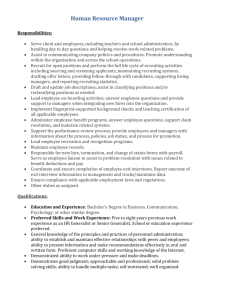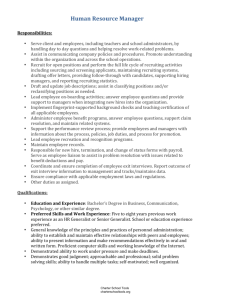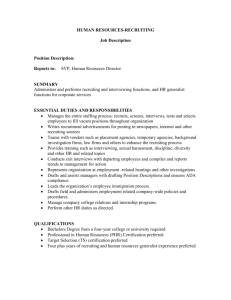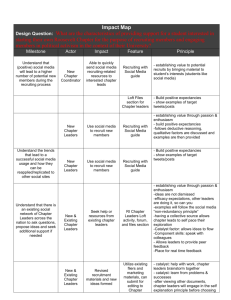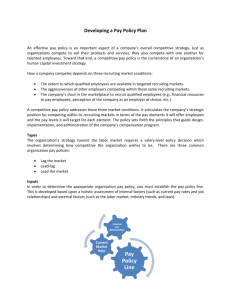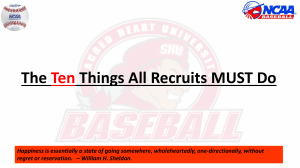Recruiting Talented Employees
advertisement
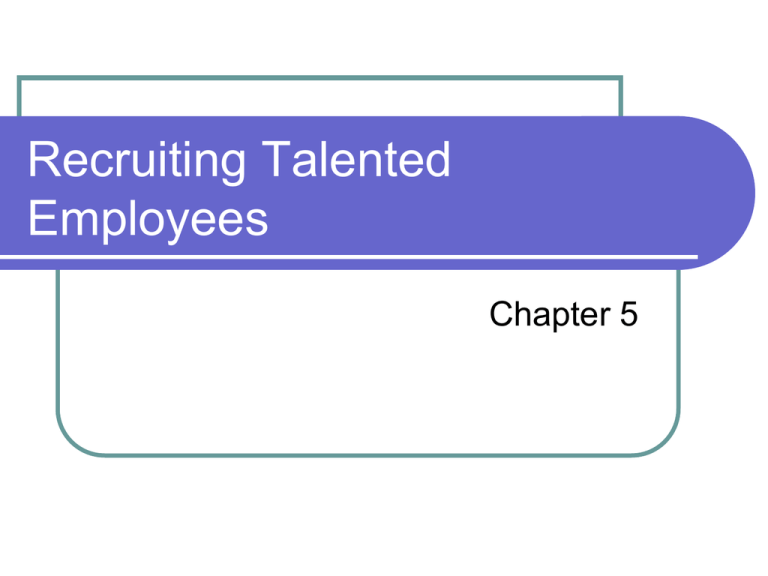
Recruiting Talented Employees Chapter 5 LEARNING OBJECTIVES After reading this chapter you should be able to: Explain how overall HR strategy guides recruiting practices. Describe the key elements of human resource planning. Explain important characteristics and search patterns of different types of people looking for jobs. LEARNING OBJECTIVES Describe the characteristics of organizations that attract recruits. List various recruiting sources and be able to describe their strengths and weaknesses, as well as their linkage with strategic recruiting practices. Explain various approaches for evaluating the effectiveness of recruiting STRATEGIC RECRUITING Employee recruiting is the process of identifying and attracting people to work for an organization. A strategic approach to recruiting helps an organization become an employer of choice and thereby obtain and keep great employees who produce superior goods and services. Recruiting Strategies There are two approaches used in business today. Broad skill scope, is a strategy that seeks to attract a large number of applicants. Targeted scope, represents a strategy that seeks to attract a small number of applicants who have specific skills or characteristics. Figure 5.1 Strategic Framework for Employee Recruiting Recruiting Strategies Broad skill scope strategy focuses on attracting a large number of applicants. This approach makes sense when a lot of people have the characteristics needed to succeed in the job. Organizations using the Bargain Laborer HR strategy would use this approach to hire a large number of nonspecialized employees, who often stay with the company for only short periods of time. Organizations with the Loyal Soldier HR strategy seek to keep employees for longer periods, but, the employees do not need specialized skills to succeed. Recruiting Strategies Targeted skill scope strategy seeks to attract a small group of applicants who have a high probability of possessing the characteristics that are needed to perform the specific job. This approach is used when you are looking for a very limited number of applicants with a very specific or rare set of skills. Internal versus External Recruiting Internal sourcing seeks to fill job openings with people who are already working for the organization. These are current employees who are ready for promotions or for different tasks. External sourcing of recruits seeks to fill job openings with people from outside the organization. Primary sources of recruits are other organizations. Extreme example of external sourcing is Independent contractors and temporary workers. Human Resource Planning Human resource planning is the process of forecasting employment needs. The process involves assessing current employment levels, predicting future needs, planning for internal movement, and predicting external hiring needs. Figure 5.2 Human Resource Planning Figure 5.3 Planning Process Example The Job Search Effective recruiting is understanding the needs, goals, and behaviors of people searching for jobs. There are three types of people looking for work: people entering the workforce for the first time. people who have been in the workforce but are currently unemployed. people who are currently employed but seeking a different job. New Workforce Entrants When do most people enter the full time workforce? When they graduate from school—either high school or college. Their job search goes through several stages. The First Stage is determining what openings exist, what qualifications are necessary, and how to apply. The Second Stage focus is on finding out specific details about particular jobs. Unemployed Workers The second group of potential job recruits consists of people who have been in the workforce but are currently unemployed. Organizations recruiting people from the unemployment ranks benefit from seeking out and encouraging people who have been laid off from other jobs to apply for openings. Workers Currently Employed Some of these individuals are actively looking for new jobs. Others are not looking but are open to a move if a good opportunity arises. People who search for alternative jobs while still employed tend to be intelligent, agreeable, open to new experiences, and less prone to worry. Organizational Attractiveness The following is a listing of general characteristics which attracted applicants to organizations. familiarity compensation organizational traits recruiting activities Familiarity Organizations with a strong brand image thus have an overall advantage when it comes to recruiting. Their efforts to advertise their products and services provide them with a good reputation that helps them attract potential employees. They don’t need to spend time and resources helping people become familiar with them. However, efforts to create an image as a generally desirable place to work are very important for less well-known companies Compensation and Similar Traits People like organizations which pay competitively and; Offer better and more flexible benefits. Greater opportunities for advancement and higher job security. Organizational Traits People like working for organizations which have positive reputations such being friendly, sincere, kind, and trustworthy. Another organizational trait is innovativeness. People want to work for innovative organizations because they think their work will be interesting and fun. A third desirable trait is competence. People want to work for an organization that is successful Recruitment Sources Organizations use a variety of sources to find job applicants. Some sources, such as referrals from current employees, are relatively informal. Other sources, such as professional recruiters, are more formal. Some of the various sources are as follows: job posting, employee referrals, print advertising, electronic recruiting, employment agencies, and campus recruiting. Factors that Influence Job Recruits Source: Information from Wendy R. Boswell, Mark V. Roehling, Marcie A. LePine, and Lisa M. Moynihan, ‘‘Individual Job-Choice Decisions and the Impact of Job Attributes and Recruitment Practices: A Longitudinal Field Study,’’ Human Resource Management 42 (2003): 23–37. Job Posting Job Posting uses the organizational internal communication channels to inform current employees about job opening and promotional opportunities. Today organization uses the company web site and email to notify employees of employment opportunities. Employee Referrals Employee referrals occur when current employees get their friends and acquaintances to apply for positions. Referrals are thought to have at least four primary strengths. First, obtaining job applicants through referrals is a relatively inexpensive method of recruiting. Second, referrals are quicker than many other forms of recruiting. Third, people hired through referrals tend to become better employees who are less likely to leave the organization. Fourth, current employees become more committed to the organization when they successfully refer someone. Increasing effectiveness of employee referral programs Source: Information from Michelle Neely Martinez, ‘‘The Headhunter Within: Turn Your Employees into Recruiters with a High-Impact Referral Program,’’ HRMagazine 46, no. 8 (2001): 48-55; Carroll Lachnit, ‘‘Employee Referral Saves Time, Saves Money, Delivers Quality,’’ Workforce 80, no. 6 (2001): 66-72. Print Advertising Employment advertisements are a major part of almost all newspapers. People who are looking for employment often search daily for work opportunities by reading the “help wanted” section of a newspaper. An advantage of newspaper advertising is thus the potential to reach a very large number of people for a relatively low cost. Newspaper advertising works particularly well for the broad recruiting associated with the Bargain Laborer HR strategy. Electronic Advertising Uses the internet, to send recruiting messages. Popular websites such as: www.Monster.com www.careerbuilder.com Increasing effectiveness of online recruiting Source: Information from Jeff Stimson, ‘‘Recruiting Via the Web,’’ The Practical Accountant 37, no. 7 (2004): 26–30. Employment Agencies Each state has a public employment agency, which is a government bureau that helps match job seekers with employers. Private employment agency is a professional recruiting firm that helps organizations identify recruits for specific job positions in return for a fee. One private agency is Kelly Services. Kelly provides placement services for more than 700,000 people annually in areas including office services, accounting, engineering, information technology, law, science, marketing, light industrial, education, health care, and home care. Campus Recruiting Campus recruiting focuses on working with specific colleges and universities to recruit graduating students. Organizations that recruit successfully work hard to build a strong reputation among students, faculty, and alumni. Relationships are built through activities such as giving talks to student organizations and participating in job fairs. Effective Recruiting Three Common Measures include: Cost Time Quantity Quality Cost Measures Cost measures include such things as the money paid for advertising, agency fees, and referral bonuses. Also included is travel expenses for both recruiters and recruits, as well as salary costs for people who spend time and effort on recruiting activities. Time Measures Time measures assess the length of the period between the time recruiting begins and the time the new employee is in the position. Estimates suggest that the average time to fill a position is 52 days. Quantity Measures Focus on the number of applicants or hires that are generated through various recruiting activities. Common measures include number of inquiries generated, number of job applicants, and number of job acceptances. These are measures of efficiency, and they provide information about the reach of recruiting practices. Quality Measures Is the extent to which recruiting activities locate and gain the interest of people who are actually capable of performing the job. Typical measures include assessments of how many applicants are qualified for the job, as well as measures of turnover and performance of the people hired. Effective Recruiting The most frequently used measures of recruiting combines assessments of cost and quantity. One measure is cost per hire, which is calculated by dividing the total cost of a particular search by the number of hires it provides. The other is cost per applicant, which is calculated by dividing the cost of a recruiting method, such as a newspaper advertisement, by the number of people who respond.
